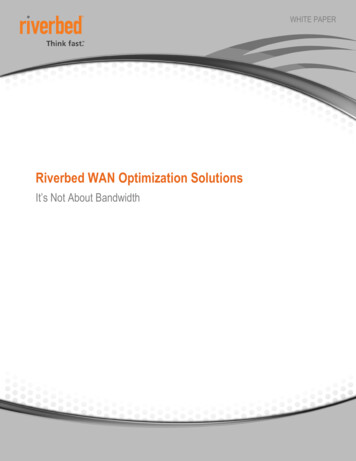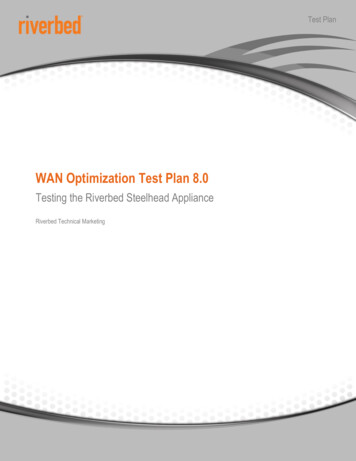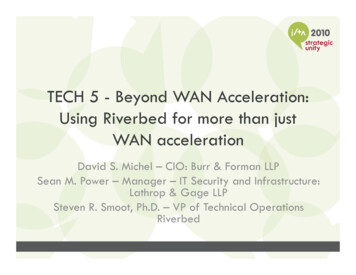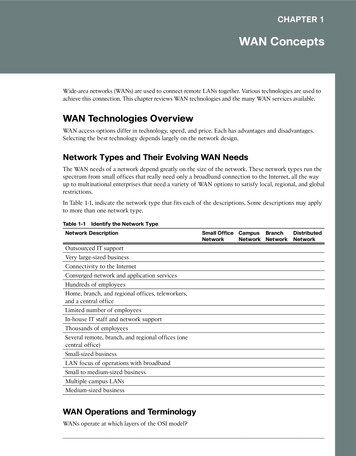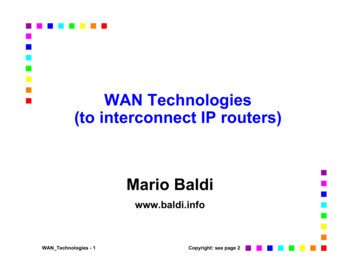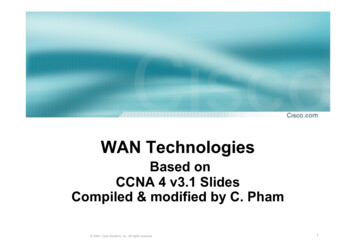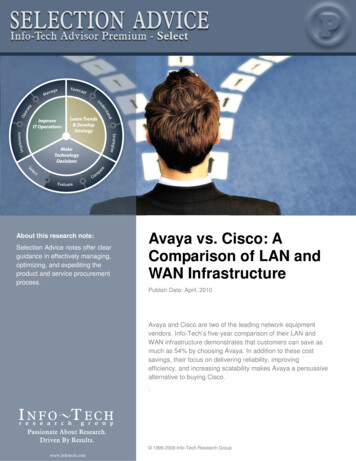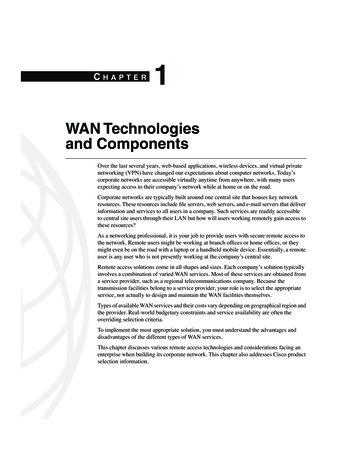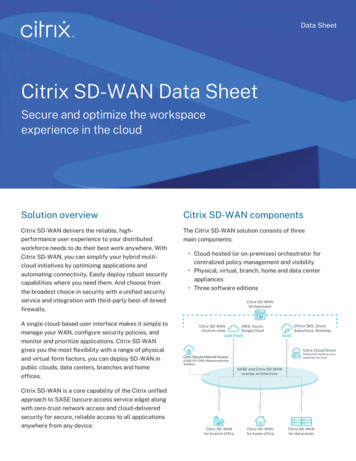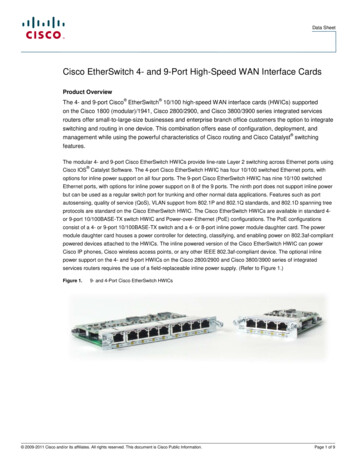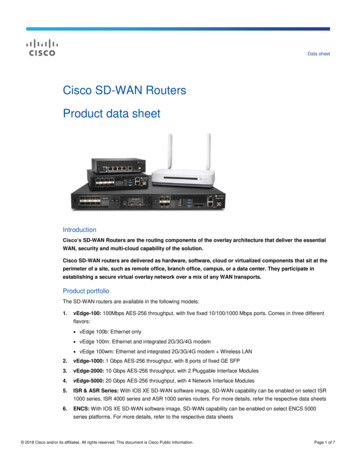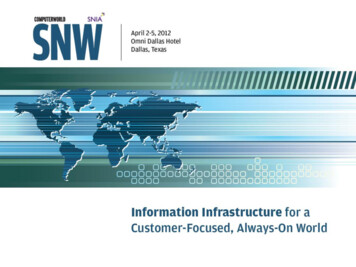
Transcription
WAN OPTIMIZATIONSrinivasan Padmanabhan (Padhu)Network ArchitectTexas Instruments, Inc.
Disclaimer“Please be aware that the concepts andopinions expressed in the following presentation arethose of the presenters (Srinivasan Padmanabhan) andmay not reflect the operational philosophies, norstrategic directions of Texas Instruments,Inc."
Agenda Wan optimization overview Criteria for evaluating wan optimization products Production readiness/methodology for deployment Case studies Questions
COMPANY OVERVIEWGlobal Semi-Conductor Design and ManufacturingBusiness problem: Time to Market Global work-flow and global teamsCollaborative design (Data and Thin Client)Regionally distributed compute resources / dataUsers want: “local” experience from the “remote” office Administrative / Knowledge worker, DesignerNetwork solution Enable use of global compute resourceSignificantly reduce bulk data transfer timesExample: 48hr transfer reduced to 4hr 18 day reduction in time tomarket
TECHNOLOGY ENVIRONMENT Wide range of networking solutions with redundantdiverse WAN architecture Product Suite for WAN Optimization- Silverpeak NX Appliances- Cisco 6500 with SUP720,7200 with NPE-G2,3845 Enable strategic network architecture that reducesdata on our Wide Area Network(Best way to save bandwidth on the WAN is not tosend data in the first place)
WAN OPTIMIZATIONTECHNOLOGY OVERVIEW
Key Technical Drivers Growing pressure on WAN Bandwidth– Data Center/Server Consolidation– Remote System Backups across WAN– Data replication and Disaster Recoveryrequirements Obstacles– Latency (Throughput inversely proportional)– Inefficient Bandwidth usage– TCP/IP Protocol inefficiencies Packet Loss/Re-transmissions
WAN OptimizationA suite of tools to mitigate network latency and improveNetwork throughput and efficient use of WAN bandwidthNormally involves one or many of the following components TCP Acceleration ( TCP Proxy – Local acks)Deduplication/Cacheing -- Network /ApplicationHeader/Payload CompressionNetwork IntegrityApplication proxyUDP Optimization ?Transport – Tunnels / Auto-DiscoveryCustom plug-in for SSL/CIFS ?
Impact of latency and loss on TCP– Performance impacted due to connection oriented mechanism– TCP throughput is inversely proportional to network latencyregardless of the bandwidth available– Layer-7 application chattiness Maximum theoretical TCP throughput– Dependent of transmission Window sizes and LatencyThroughput (bps) TCP Window size (bytes) / Latency (seconds)RTT (ms)Throughput in Kbps1080385049821003377200205430014764001152500944
Impact of latency and loss on TCP40.0100ms20.050ms10ms10.0Packet Loss 100%0.050%0.020%0.00.010%Maximum Throughput (Mbps)30.0
Network based cachingData CenterWhen similar informationis recognized it isconveyed via a referenceto the remote networkmemory.A single instance ofinformation is populatedin each appliance basedon normal networkusage.DataCenterOffice AOffice ADataCenterAll appliances knowthe state of eachother’s memory.WANBranch Office AInformation is deliveredlocally when possible
Network De-duplication at workComplete file sent to serverData CenterLocal Instance UpdatedOffice ADataCenterDataCenterOffice ALocal Instance UpdatedOnly delta traverses WANWANBranch Office AFile modified and sent
Network vs Content CachingWeb/File CacheCaches a single data type–Benefits limited to a singleapplicationIdentifies content by URL/filename–Changing name defeats cacheRecognizes pages/objects––Whole object must be identicalAll or none cache resultLimited coherency guarantees––Freshness vs efficacy tradeoffLocal authentication and lockingNetwork CacheingWorks with all applications–Benefits broad range ofapplicationsExamines content itself–Renaming does not affectoperationRecognizes content at byte level––Detects similar/modified contentCan send byte granular deltas100% coherent––No chance of stale dataNative application handleslocking etc
CRITERIA FOR EVALUATING WANOPTIMIZATION PRODUCTS
Criteria for site selection for deployment of WAN Accelerators Latency sensitive applications impacting performance ( 40ms)Limited Bandwidth impacting performance ( 10 Mbps)Need for faster bulk data transferNeed for WAN encryptionData Center ConsolidationCost avoidance opportunities by leveraging data reductionCost savings opportunity to scale down bandwidth
Phase-I TestingApplications performance test criteriaFTP (100MB file /40ms delay/first pass/second pass)FTP (100MB file /500ms delay/first pass)CIFS (100MB file /40ms delay/first pass/second pass)CIFS (100MB file /500ms delay/first pass/second pass)CIFS (21MB file /32ms delay /20mb bw /first pass)FTP (100MB file /32ms delay/20mb bw / first pass)SSL Applications – with and without CERTsThin Client at both low and high latency – What tweaks are required ?Performance ComparisonLow latency throughputHigh latency throughputUtilization with dropsUtilization when circuit is 50% loaded
Phase-II TestingAdvanced Functions: Configure and test out of band via WCCP (wccp throughput check) Configure and test out of band via PBR Asymmetrical routing support Test appliance behavior when flows or appliance max throughput areexceeded Exclusion/ Inclusion of ports, IP address from acceleration Enterprise network topology feasibility Physical Topology awareness (subnet/network configuration) Support for multi hop transport Can it rate limit ? Scalability (Bandwidth and Flows) - Cost per flow Encryption of accelerated data Protocols accelerated ( TCP/UDP) Support for virtualization Support for Dot1q trunks Centralized management/Reports / Troubleshooting / Support
Throughput anomalies . How is the improvement for bulk dataapplications at low latencies? What about throughput improvementat high latencies? With errors introduced in the pathwhat is the net effect on throughput atboth high and low latencies. Is there any difference in performancebased on inline vs out of path ?
PRODUCTION READINESS&DEPLOYMENT METHODOLOGY
Deployment Modelsa) Out of path- WCCP (L3 or L2)- PBR Policy Based Routingb) Inline ( Sites with single Data VLAN)c) Physical Inline with Dot1q(Sites with multiple VLANs trunked to WAN Router)
PBR/WCCP ModelWCCP Group 51 and 52 (TCP and UDP), include both routersRouter ACL Config: permit LAN-A to LAN-BWCCP Group 51 and 52 (TCP and UDP), include both routersRouter ACL Config: permit LAN-B to LAN-A22
Inline / Virtual Inline Model Inline – Wire in / Wire out –Relay bypass Virtual Inline - Uses VLAN xx a Transit VLANto get LAN traffic passed through theappliance. Ability to bypass the WAC by short circuitingVLAN xx with default data vlan.
CASE STUDIES- Improving application throughput on the WAN- Reducing cycle time for DR/ Bulk data transfers- Optimizing thin client applications over highlatency WAN circuits
Use case with (SnapVault)1.68 GBSnapvault Datasent toacceleratorfrom NetAppFilerAcceleratorsent 126 MB ofdata over WANafter datareduction.DataReduction ratiois 13.278x or93%
SSL Optimization with WAN AcceleratorsTest#Test DescriptionFile TypeFile SizeLatencyBandwidthTime Elapsed(In Seconds)without WANoptimizationTime Elapsed(In Seconds)with WANoptimization1Load Sharepoint urlhttps0.2MB300ms10 Mbps1152UploadWord7MB300ms10 Mbps97203DownloadWord7MB300ms10 Mbps82304DownloadExcel27MB300ms10 Mbps284935DownloadPowerPoint47MB300ms10 Mbps4961916DownloadExcel55MB300ms10 Mbps559877DownloadWord87MB300ms10 Mbps90078
Application Performance with WAN AcceleratorsTest CasesAccelerated BaselineRemarksFTP (100MB file /500ms delay)47 secs18mins 50 secs23X BW increaseCIFS (20MB file /500ms delay)11 secs4 mins22X BW increaseCDDS/HTTP (80MB file /300ms delay)53 secs11 min12X BW increaseRsync with ssh (100MB file /500msdelay)11min 8 secs18 minsNo IPSECRsync with rsh (100MB file /500msdelay)56 secs18 minsWith IPSECSFTP (680MB file /320ms delay)1 hr 30 min1 hr 36 minFTP (680 MB file /320ms delay)4 min 10 sec1 hr 36 minMobilize (4GB file /320 ms delay)14 min4 hr 34 min23X BW increase
Leveraging WAN Accelerationfor Thin client TCP acceleration - Latency mitigation- Performance improve significant when latency is above 100ms- Higher the latency better the performance- Improves predictability in keystrokes and mouse moves Network Integrity corrections optimizes dirty links Local ‘ack’ addresses chatty applications Compression effectively reduces initial transfer Network Cacheing- Cumulative benefit as more users access same thin client farm- Saves wan bandwidth that potentially could be made available forother bulk data applications
Few good use cases .For achieving best performance using WANAcceleration:– Disable application compression– Leverage SSL optimization where possible– Actively manage thin client environment toleverage WAN optimization– Disable encryption (ssh/sftp) * Exceptions from Security may berequired– Files to be in native format (no zip/compressedfiles)– Works best for bulk data transfers– No ssh/secure wrappers
WAN OptimizationQuestions ?
WAN OptimizationThank you !!
diverse WAN architecture Product Suite for WAN Optimization - Silverpeak NX Appliances - Cisco 6500 with SUP720,7200 with NPE-G2,3845 Enable strategic network architecture that reduces data on our Wide Area Network (Best way to save ban
